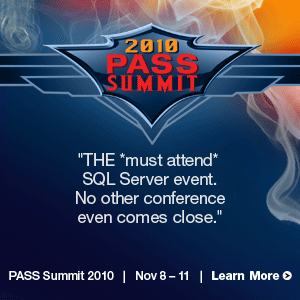The following is some information I would like to share with the community about how I plan to travel to Seattle for the SQL Server Pass Summit. Please take my information with a grain of salt because this is the first time I am attending. Everything below comes from research and tweets. If you are a regular please leave comments so others can see your travel tips.
Summit 2010

- Can we fast forward to November?
The SQL PASS Summit 2010 is the best opportunity for SQL Server DBA’s to connect, share and learn. Your first obstacle towards getting into the Summit is to well pay for general admission to the summit. You basically have two options here, either you pay the general admission fee (this is what I am doing this year) or you can get someone to sponsor you. A great option here would be your employer. Your employer also isn’t your only option for sponsorship. Speaking of getting someone else to sponsor you MSSQLTIPS and Idera is currently looking to send someone to PASS. Give it a shot it could be you!
If you are paying for yourself you will want to pay ASAP because PASS has a sliding scale. Just like many other conferences there is a price before sessions are announced and different prices as you get closer to the event. You want to avoid paying at the door because the price is usually a lot more.
The following are some links that will help you save some money on attending the 2010 Summit.
How do I get there?
How you get to the PASS Summit will depend on your location and its distance to Seattle. I live in Wheeling, WV which is an easy hour drive to Pittsburgh so I will be flying. If you are also flying you might want to checkout bing.com and setup email alerts to track the change in flight prices. At this time I see that there are round-trip flights under $300 from Pittsburgh.
In order to travel through the Seattle Metro area check out the public transportation system. It looks like they have bus, and a monorail. The Seattle Center Monorail can take you from the airport to downtown for $5.00 round-trip.
Where Should I stay?
The PASS website recommends the following two hotels.
Looking at bing.com and traveladvisor.com I found a few hotels within a miles of the convention center under $100 per night. If you are trying to stretch your money I would recommend checking them out.
Do you have any friends that are attending PASS? If so, you might want to recommend sharing a room. This is a great way for you to split the costs of a hotel room.
Where should I eat?
If you are attending the Summit there is good news. Breakfast and Lunch is included daily. This means you will only have to worry about dinner. There will also be some evening events where you might be able to snag a bite to eat. On Monday night you can attend the PASS Summit 2010 Welcome Reception. On Tuesday night you can also attend the Exhibitor Reception.
Another thought towards saving some $$ on dinner is to talk it up with the vendors. They are there to get to know you and see if their products can solve your problems. If your team has a budget for SQL tools (I really hope your team does) I bet you could convince a vendor to take you out to dinner. Even if you don’t have a budget for SQL Tools I bet you could convince some vendors to take you out to dinner. Remember most people in sales try to build relationships before they sell you on a product or idea.
Can you buy me a drink?
I never really was a big fan of beer and alcohol until I started my career in Information Technology (we will leave the company name out of this story). There were several internal functions to attend for networking and they all had beer. I quickly noticed that all the bigwigs always had a beer in their hands. Being fresh out of college I followed suite and soon fell in love with beer (a trip with the wife to tour Samuel Adams in Boston also helped).
Anyways back to saving money. If you like to grab a drink (I defiantly fall into this category) it looks like its cheaper to go away from the convention center.
According to @SQLDBA its cheaper to go to the Tap House across the street from the convention center. If you also like to sample local beer the Rock Bottom Brewery is another recommended place within walking distance from downtown.
What are your travel plans?
PASS Summit vets what am I missing? How else can people save some $$ on their quest to their first Summit conference? Let us know we are all looking forward to your recommendations.
















